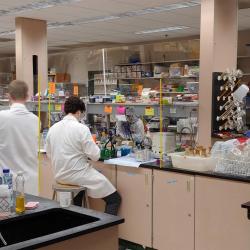
Allison (Niggemyer) Evans
Instructor
Department of Microbiology
Allison (Niggemyer) Evans
Instructor
Department of Microbiology
Research
Teaching:
- MB 303: General Microbiology Laboratory
- BHS 323: Microbial Influences on Human Health
- BHS 329: Mechanisms of Disease
- MB 330: Disease and Society
- BHS 316: Immunology
Research Interests:
- Physiology of Anaerobes
- Aquatic Biogeochemistry
- Aquatic Ecology and Limnology
- Fish Physiology
- Scholarship of Teaching and Learning
Selected research publications below. For a complete list, see Allison's Google Scholar profile.
Education
Ph.D., Oregon State University, Fisheries Science
M.S., University of Idaho, Environmental Science (Microbial Ecology)
B.A., DePauw University, Biology and Music
Publications
- Richter, C.A., Evans, A.N., Heppell, S.A. et al. Genetic basis of thiaminase I activity in a vertebrate, zebrafish Danio rerio. Sci Rep 13, 698 (2023). https://doi.org/10.1038/s41598-023-27612-5
- Eiler, J. H., Masuda, M. M., & Evans, A. N. (2023). Swimming depths and water temperatures encountered by radio-archival-tagged Chinook Salmon during their spawning migration in the Yukon River basin. Transactions of the American Fisheries Society, 152, 51–74. https://doi.org/10.1002/tafs.10386
- Eiler, J. H., Masuda, M. M., & Evans, A. N. (2022). Using radio-archival tags to determine the swimming depth, movements, thermal conditions, and exposure to elevated temperatures for Yukon River Chinook salmon stocks. https://doi.org/10.25923/4emd-mt47
- Murphy, C., Evans, A., Coffin, B., Arismendi, I., and S. Johnson. 2019. Resilience of zooplankton communities in temperate reservoirs with extreme water level fluctuations. Inland Waters 10(2): 256-266. DOI: https://doi.org/10.1080/20442041.2019.1657349
- Harder, A., Ardren, W., Evans, A., Futia, M., Kraft, K., Marsden, E., Richter, C., Rinchard, J., Tillitt, D., and M. Christie. 2018. Thiamine deficiency in fishes: causes, consequences, and potential solutions. Reviews in Fish Biology and Fisheries 28 (4): 865-886
- Richter, C.A., Evans, A.N., Wright-Osment, M.K., Zajicek, J.L., Heppell, S.A., Riley, S.C., Krueger, C.C., and D.E. Tillitt. 2012. Paenibacillus thiaminolyticus is not the cause of thiamine deficiency impeding lake trout recruitment in the Great Lakes. Canadian Journal of Fisheries and Aquatic Sciences 69:1056-1064. DOI: 10.1139/f2012-043
- Riley, S.C., Munkittrick. K.R., Evans, A.N., and C.C. Krueger. 2008. Understanding the ecology of disease in Great Lakes fish populations. Aquatic Ecosystem Health and Management 11: 321-334. DOI: 10.1080/14634980802301638
- Cummings, D.E., Snoeyenbos-West, O., Newby, D.T., Niggemyer, A.M., Lovley, D.R., Achenbach, L.A., and R.F. Rosenzweig. 2003. Diversity of geobacteraceae species inhabiting metal-polluted freshwater lake sediments ascertained by 16S rDNA analyses. Microbial Ecology. 46(2):257-269. DOI: 10.1007/s00248-005-8002-3
- Niggemyer, A., Spring, S., Stackebrandt, E. and R F. Rosenzweig. 2001. Isolation and characterization of a novel As(V) reducing bacterium: Implications for arsenic mobilization and the genus Desulfitobacterium. Applied and Environmental Microbiology. 67 (12): 5568-5580. DOI: 10.1128/AEM.67.12.5568-5580.2001



